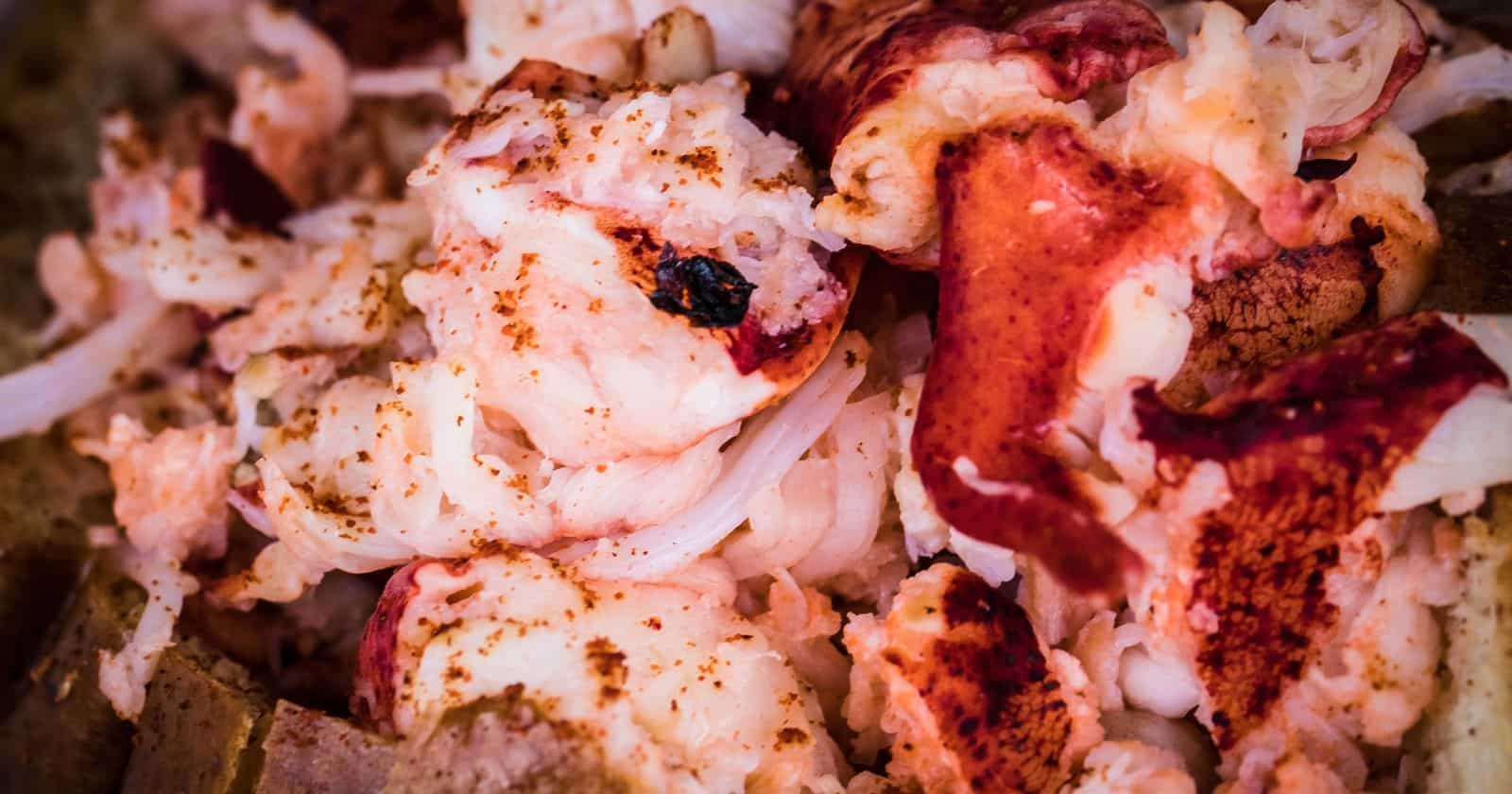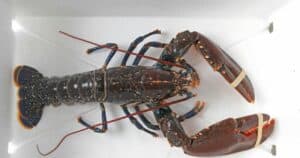Are you the type who loves to indulge in a delicious lobster dinner but always wonders how much meat you’re getting out of it? Many people are concerned about getting the most bang for their buck with this indulgent seafood dish.
On average, a 1-pound lobster will yield about three ¼ ounces of meat, but this can vary depending on the season and size of the lobster. If you want to get the most out of your lobster, opting for an enormous hard-shell lobster will give you more meat than a smaller one.
In this article, we’ll delve into how to get the most out of your lobster, the different types of lobsters, and how to cook them to perfection. Get ready to become a lobster connoisseur with our helpful tips and tricks.
The Anatomy of a Lobster: Understanding Where the Meat is
A lobster’s meat can be found in various parts of its anatomy, specifically in the claws, knuckles, body, and head. The cephalothorax, which comprises the head, midsection, and tail, all have edible meat. But where exactly is the tenderest meat located?
It’s in the claws, with the knuckles connecting them to the carapace. And remember to underestimate the rib meat, located between thin shells of the body and head.
Interestingly, lobsters have a heart behind their stomach that pumps their greyish/clear blood through large vessels.
Diving deeper into the topic, here are some other interesting facts about the anatomy of a lobster:
- The claw on one side of the lobster’s body is usually more extensive and more robust than the other. This is because lobsters are typically right or left-handed, just like humans!
- Lobsters have an exoskeleton made up of chitin that protects their body. As they grow, they’ll shed this exoskeleton and develop a new one.
- In addition to their heart, they have an open circulatory system. This means that their blood doesn’t flow through veins and arteries like humans, but instead, it’s pumped directly into their body cavity and bathes their organs before drifting back into their hearts.
- Lobsters have two stomachs, one containing teeth that help them grind food.
- Female lobsters have a pair of small appendages called swimmerets to carry their eggs until they hatch.
How Much Meat is in a Lobster: The Average Amount and How It Varies
How much meat is in a lobster? On average, a live lobster contains about 20% meat, with the remaining 80% being shell and waste. But that number can vary depending on different factors. For example, soft-shell lobsters caught in the summer yield less meat than other lobsters.
Also, the size and type of lobster are critical factors in determining the amount of meat. Live lobsters can produce up to 30% meat, which is good news for seafood lovers!
Now, let’s dive deeper into the topic. Here are some additional facts about how much meat is in a lobster:
- The yield of lobster meat varies by the type of lobster. For example, Maine lobsters generally yield more meat than spiny lobsters.
- The yield of lobster meat also varies by the season. Soft-shell lobsters caught in the summer have less meat than hard-shell lobsters caught in the fall.
- A 1-pound lobster will typically yield about three ¼ ounces of meat. However, more giant lobsters can yield up to 7 or 8 ounces of meat.
- There are different types of lobster meat. The tail is the most popular section, but meat is also in the claws, legs, and body.
When cooking lobster, it’s essential to keep the amount of meat in mind. For example, if you’re feeding a large group, you’ll need more lobsters to get enough meat for everyone. Additionally, the type of lobster you choose and the time of year can impact how much meat you’ll get.
Types of Lobsters: Hard-Shell, Soft-Shell, and Spiny
Did you know that lobsters come in different types? There are hard-shell lobsters, soft-shell lobsters, and spiny lobsters. Let’s dive deeper into these types and discover the differences.
Hard-shell lobsters are the most common and preferred type of lobster for eating. They have a tough outer shell that protects the meat inside, making them perfect for transport and storage. Hard-shell lobsters are also known for having a higher meat yield than soft-shell lobsters. On average, they contain 20% to 28% meat and have more meat per pound. Hard-shell lobsters are prized for their delicious, succulent meat and are a popular delicacy worldwide.
On the other hand, soft-shell lobsters have softer, more delicate shells that are easier to crack open than hard-shell lobsters. However, they have less meat than their hard-shell counterparts. Soft-shell lobsters contain up to 30% less meat, and the difference is mostly water. They are also more difficult to store and transport due to their delicate shells, making them less common in the market.
Spiny lobsters are different from hard and soft-shell lobsters as they have no claws, and their meat is in their tails. They have a spiny outer shell that protects their tail meat, considered some of the tastiest lobster meat. Spiny lobsters are famous in warm water regions such as the Caribbean, Mediterranean, and South Africa.
Tips for Choosing the Best Lobster: Factors to Consider
When choosing the best lobster, there are a few factors to remember. First, look for a live lobster in the tank that’s active and moving around. This is a good indicator of tender meat. Also, take note of the antennae – longer ones are a sign of better quality.
Soft-shell lobsters are generally better than hard-shell ones since they contain less fat. Ensure you steer clear of lobsters with cracked shells or missing limbs, and always check for signs of life.
If you’re selecting a lobster for just one person, go for one that weighs around 1 ½ pounds. This will provide just the right amount of meat without being too overwhelming.
However, if you’re choosing a lobster for a larger group or a special occasion, you may want to consider a larger size. Remember that the larger the lobster, the more challenging the meat may be.
When cooking your lobster, there are several ways to prepare it: grilling, steaming, boiling or baking. Each method has its unique benefits and drawbacks, so it’s up to you to decide which one you prefer. Regardless of the cooking method, be sure to add plenty of seasoning to enhance the flavor of the meat.
Step-by-Step Guide: How to Crack a Lobster
Cracking open a lobster can be pretty challenging if you don’t know what you’re doing. Here’s a step-by-step guide on how to do it quickly and effectively.
- First, give the lobster a good squeeze inwards along its length until it cracks. Then, pull it in the opposite direction to separate the meat.
- Next, open the underside of the body by breaking it apart in the middle with the small walking legs on either side. Extract the meat from the leg joints and legs carefully, not leaving any behind.
- Now for the claws. Hold the lobster over a large bowl and break the tailpiece away from the body. Then, pull the leg/claw piece from the lobster’s body. It can be a bit tricky to get those claws open but don’t worry. Simply open each foot with a nutcracker or seafood cracker, revealing the succulent meat inside.
- If you’re feeling adventurous, you can also try extracting the meat from the lobster’s body. This requires a bit more finesse but can provide delicious beef. Using a pair of kitchen shears, carefully cut down the body’s center, splitting it in half.
- Remove the green tomalley, the sand sac, and the roe, if there is any. Then, carefully remove the meat from the body cavity and enjoy.
How to Get the Most Out of Your Lobster: Maximizing the Meat Yield
Did you know that buying a more enormous lobster can yield more meat? More giant lobsters often provide a better product, and their heart is less challenging than smaller ones. However, be careful not to overcook them as it can make the meat dry and rubbery.
For the best yield, consider storing the cooked lobsters on their backs to keep the juices in. After that, refrigerate them for 1-2 days. If you want to keep lobsters alive at home, cover them with moist seaweed or a damp cloth and refrigerate them. This way, they will stay fresh longer.
But that’s not all! Here are some more tips on how to maximize your lobster meat yield:
- Choose the right claws: The larger nails generally have more meat, so choose them over the smaller ones.
- Crack the lobster properly: There are many ways to crack a lobster, but the best way is to start at the body and work toward the claw. This way, you will avoid breaking the meat prematurely and enjoy the maximum yield.
- Cook the lobster correctly: Overcooking can make the meat tough and mushy, while undercooking can leave it raw and stringy. Boiling or steaming are the best ways to cook lobster, and it should be done for 7-9 minutes for a one-pound lobster.
Remember, cold-water lobster tails are usually more expensive than warm-water lobster tails, so consider this when buying. With these tips, you can maximize your lobster meat yield and enjoy every bit.
The Cost of Lobster: Is It Worth the Price?
A lobster dinner can range from $30 to $100 due to increased demand and decreased supply. However, it is worth the price for many people because of its delicious taste and quality.
Many restaurants charge high prices for lobster because of its high demand, scarcity, and cost to catch and prepare it. Despite the high cost, many believe lobster is worth the price because of its unmatched flavor and texture.
In addition to its taste, lobster is also a low-fat and high-protein source of nutrition. It contains calcium, iron, and potassium minerals, making it a healthy food option. Moreover, lobster is a luxurious meal that makes any occasion special.
Lobster is a popular menu item in many restaurants worldwide despite its high cost. In Maine, lobster is not just a dish but a way of life. Maine lobstermen have been harvesting lobsters for generations, providing high-quality seafood to customers near and far. Thus, the cost of lobster is worth it for many people, and they consider it a delicacy worth the price.





